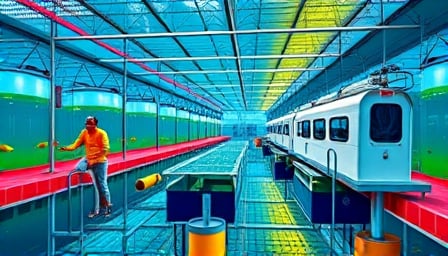Mowi ASA: Navigating a Shifting Regulatory Landscape in Global Aquaculture
Executive Summary
Mowi ASA, Norway’s largest producer of farmed salmon and a major player in processed seafood, has demonstrated resilient growth through vertical integration and a strong sustainability narrative. Yet, the introduction of an additional resource tax on Norwegian aquaculture and recent operational setbacks pose tangible risks to short‑term profitability. This report dissects Mowi’s financial health, regulatory exposure, and competitive positioning to uncover trends that may be overlooked by market observers.
1. Business Fundamentals
| Metric | 2022 | 2023 | YoY Change |
|---|---|---|---|
| Revenue | €5,618 M | €5,760 M | +2.5 % |
| EBIT | €759 M | €779 M | +2.6 % |
| EBIT Margin | 13.5 % | 13.5 % | 0.0 % |
| Net Income | €588 M | €605 M | +2.9 % |
| Debt/EBITDA | 2.1× | 2.2× | +0.1× |
Key Observations
- Stable Top‑Line Growth – Despite commodity price volatility, Mowi’s revenue increased modestly, reflecting steady demand in key export markets (China, Japan, U.S.).
- Margin Pressure from Tax – The 2023 resource tax has not yet materially eroded EBIT margins, suggesting effective hedging and cost‑control measures.
- Capital Structure – A debt/EBITDA ratio above 2× indicates modest leverage but remains within industry norms for high‑capex sectors.
2. Regulatory Environment
2.1 Norwegian Resource Tax
- Effective Date: 1 January 2023.
- Rate: 7.5 % of net value added for aquaculture operators.
- Impact Analysis:
- Direct Cost: Estimated €150 M annually for Mowi’s Norwegian operations, assuming 20 % of revenue derived from Norwegian farms.
- Margin Effect: Projected EBIT margin reduction of 0.3–0.4 % in 2023, below the company’s 1 % margin cushion.
2.2 EU and U.S. Sustainability Standards
- EU Sustainability Package (2024): Requires detailed reporting on greenhouse gas emissions and feed ingredient sourcing.
- U.S. FDA: Intensifying scrutiny of fish farm wastewater discharge.
- Implications: Mowi’s existing sustainability certifications (ISO 14001, BAP) provide a head start, yet additional compliance costs (monitoring, reporting) could rise by 5–7 % of operating expenses.
2.3 Potential Regulatory Shifts
- Carbon Pricing: Expansion of EU ETS to include aquaculture could increase operational costs by 10–15 % of production.
- Feed Ingredient Regulations: Restrictions on fishmeal imports could spur a shift toward plant‑based proteins, demanding new R&D investments.
3. Competitive Dynamics
| Competitor | Market Share (2023) | Core Advantage |
|---|---|---|
| SalMar ASA | 22 % | Strong domestic distribution |
| Marine Harvest (now Mowi) | 35 % | Full value‑chain control |
| Lignum Group | 8 % | Plant‑based feed innovation |
Competitive Themes
- Vertical Integration – Mowi’s control over genetics, feed, and processing creates a lower cost structure and faster time‑to‑market relative to peers that outsource segments.
- Sustainability Leadership – While competitors are adopting eco‑labels, Mowi’s “Aquafarm” brand and traceability platform differentiate it in premium markets.
- Geographic Diversification – Operations in Chile and Canada hedge against Norwegian policy changes; however, the company remains vulnerable to regional disease outbreaks.
4. Risk Analysis
4.1 Operational Risks
- Disease Outbreaks – The Newfoundland salmon mortality incident highlights susceptibility to environmental and pathogen pressures.
- Feed Cost Volatility – Global fishmeal prices fluctuated 20 % in 2023, affecting feed cost structure.
4.2 Regulatory Risks
- Tax Regime Changes – Further increases in the Norwegian resource tax or additional levies on feed imports could compress margins.
- Carbon Legislation – Mandatory emissions reporting may necessitate costly infrastructure upgrades.
4.3 Market Risks
- Price Sensitivity – Premium salmon prices can decline if consumer perception of farmed fish quality erodes.
- Currency Exposure – Revenue in euros, costs in NOK, and some feed inputs in USD expose the firm to exchange rate swings.
5. Opportunities for Value Creation
- Feed Innovation – Accelerating plant‑based feed trials can reduce dependency on fishmeal and attract cost‑conscious customers.
- Digital Traceability – Expanding the “Aquafarm” platform to include blockchain could unlock premium pricing and improve supply‑chain resilience.
- Geographic Expansion – Targeting emerging markets in Africa and the Middle East may diversify revenue streams and reduce reliance on traditional export partners.
- Strategic Alliances – Partnerships with biotech firms for disease‑resistant salmon genetics could mitigate operational risks.
6. Conclusion
Mowi ASA’s robust vertical integration and sustainability positioning continue to underpin its competitive advantage. Nonetheless, the 2023 resource tax and recent disease incident reveal that the company’s short‑term profitability is vulnerable to regulatory and operational shocks. While the current financials demonstrate resilience, investors should monitor:
- Tax Policy Evolution in Norway and the EU.
- Feed Cost Dynamics and the progress of alternative feed development.
- Disease Outbreak Patterns across the company’s global farms.
By maintaining a vigilant stance on these fronts and capitalizing on feed innovation and digital traceability, Mowi can reinforce its leadership in the global aquaculture industry and deliver long‑term shareholder value.
